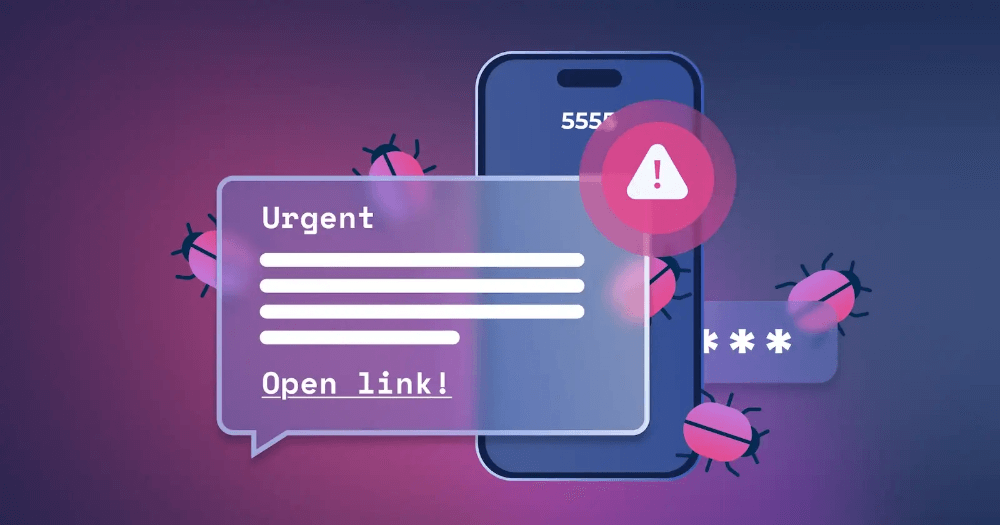📑Table of Contents:

Text messaging has become one of the most direct and effective ways for businesses to reach customers. Unlike email or social media, SMS feels personal. Messages arrive instantly, are usually read within minutes, and create a sense of urgency that other channels cannot match. However, this very strength also makes SMS a target for abuse. As businesses embrace SMS, criminals and spammers are exploiting the channel to trick users and damage trust.
Today, smishing attacks, spam overload, and fraudulent text campaigns are some of the biggest threats to SMS as a marketing and communication tool. To keep text messaging effective, businesses must fight these threats, follow compliance guidelines, and build trust with every customer interaction.
What Exactly Are SMS Threats?
When people think of text messaging, they think of quick notes from friends or alerts from trusted brands. But not every message is safe. SMS threats are deceptive or malicious messages that aim to steal information, spread scams, or annoy recipients. They usually fall into three main categories:
- Smishing – A form of phishing delivered via SMS. Attackers impersonate banks, delivery companies, or other trusted entities and ask users to click dangerous links or share personal details.
- Spam – Unwanted, irrelevant, or overly frequent texts sent without permission. Spam clogs inboxes, annoys users, and makes people distrust all business texts.
- Fraudulent Campaigns – Fake promotions or sweepstakes that look real but exist only to trick recipients into giving away sensitive data or making unsafe purchases.
These threats hurt both customers and legitimate businesses. While scammers steal money or personal data, genuine brands suffer from reduced trust, lower engagement, and stricter scrutiny.
Smishing: The Silent Danger
Smishing is growing at an alarming rate. Attackers prey on the immediacy of text messages, knowing that people are more likely to trust and act on an SMS compared to an email. For example, a smishing text might say:
“Urgent: Your bank account is locked. Click here to verify your details.”
The message looks urgent, and the short nature of SMS often makes it harder to spot inconsistencies. Victims who click the link may be redirected to a fake website designed to capture login credentials.
According to the Federal Trade Commission, smishing scams cost consumers hundreds of millions each year. And the numbers are growing. Unlike email, where filters are sophisticated, SMS inboxes are still vulnerable, giving scammers more room to operate.
Why Smishing Hurts Legitimate Businesses
The danger is not limited to victims. Even if your business does everything right, customers may grow wary of SMS as a whole if scams continue to rise. When people cannot easily distinguish between a trusted text and a fake one, they may ignore all messages. For retailers, restaurants, banks, and healthcare providers, this mistrust can translate into lost sales, weaker engagement, and damaged reputations.
For example, if a scammer impersonates a retail brand with fake discounts, customers may hesitate to open real promotions from that same brand later. One bad experience often taints the entire channel.
The Problem of SMS Spam
Spam is another threat that weakens SMS marketing. Many businesses fall into the trap of sending too many texts or irrelevant offers. Even if the messages are technically legal, recipients may perceive them as spam.
Spam hurts in two ways. First, it frustrates customers who feel overwhelmed by notifications. Second, it conditions users to treat all texts — even valuable ones — as unimportant. Over time, engagement drops, opt-out rates rise, and the channel loses effectiveness.
Unlike smishing, which is malicious, spam often results from poor SMS practices. But the damage is the same: erosion of trust.
Best Practices for Combating SMS Threats
Businesses cannot afford to sit back. Protecting customers means combining technology, compliance, and smart communication strategies. Here are the most effective ways to fight smishing and spam while preserving trust:
1. Use Verified Sender IDs
Sender verification is a simple but powerful step. Instead of sending texts from random numbers, use a registered short code or branded sender ID. Customers who see your brand name in the sender field are more likely to trust the message. It also makes impersonation harder for scammers.
2. Educate Customers
Awareness is one of the strongest defenses. Teach customers how to spot suspicious texts. Remind them that you never ask for passwords, credit card numbers, or personal details via SMS. Some banks already include safety reminders at the bottom of their texts, reinforcing safe habits.
3. Implement Spam Detection and AI Filters
Carriers and SMS platforms now use advanced spam detection systems. These tools analyze message patterns and block suspicious activity before it reaches the user. AI can identify unusual sending volumes, strange links, or inconsistent language that often indicates a scam.
4. Follow Compliance Guidelines
Legal compliance is more than a checkbox. Regulations like the TCPA in the United States and GDPR in Europe exist to protect consumers from unwanted texts. Businesses must always gain explicit opt-in consent before sending messages. Every SMS should also include a clear opt-out option. Following these rules not only avoids fines but also builds customer confidence.
5. Send Value-Driven Messages
The easiest way to avoid being labeled as spam is to provide real value. Customers should feel that every message they receive is worth their attention. Share exclusive offers, time-sensitive deals, or critical updates instead of generic marketing blasts.
6. Monitor Campaigns Closely
Pay attention to engagement data. If open rates or click-through rates decline, it may signal that your messages feel spammy or irrelevant. Encourage feedback and use surveys to understand customer preferences.
7. Limit Frequency
Less is more. Bombarding users daily almost guarantees opt-outs. Create a balanced schedule where each message serves a clear purpose. For example, weekly offers or limited-time alerts may feel helpful, while constant reminders may annoy.
8. Leverage Two-Way Messaging
Allowing customers to reply increases trust. Two-way messaging feels conversational and human. It reassures customers that they are speaking to a real brand rather than a spam bot.
Building Long-Term User Trust
Trust is the foundation of successful SMS marketing. Once it is broken, it is difficult to repair. To strengthen trust, businesses should adopt these habits:
- Be transparent: Let users know what to expect when they subscribe.
- Be consistent: Send messages at predictable times so customers recognize your patterns.
- Be respectful: Always honor opt-outs immediately and never resell phone numbers.
- Be authentic: Use clear, simple language that aligns with your brand voice.
When customers trust your texts, they are far more likely to engage, purchase, and remain loyal.
The Role of Carriers and AI
Businesses are not alone in this fight. Mobile carriers and SMS platforms are investing heavily in security. AI-powered tools now scan billions of messages daily to detect fraud, spam, and unusual activity. These tools can block harmful messages in real time before they ever reach the recipient.
For example, machine learning can detect when a single number is sending thousands of identical messages in minutes — a common spam pattern. It can also analyze links and compare them against known databases of malicious websites.
The combination of carrier-level protection and brand-level best practices creates a safer ecosystem for everyone.
Looking Ahead: The Future of SMS Security
The threat landscape will continue to evolve. Smishing attacks may become more personalized, using stolen data to appear even more convincing. Spam filters will grow stronger, but so will the creativity of scammers.
To stay ahead, businesses must remain proactive. This means staying up to date with regulations, adopting new technologies, and continually educating customers. In the future, stronger identity verification, blockchain-based trust systems, and advanced AI may make SMS even more secure.

Final Thoughts
SMS remains one of the most personal and powerful tools in digital communication. Yet, its future depends on trust. Smishing, spam, and fraudulent campaigns can erode that trust quickly. Businesses that prioritize security, compliance, and transparency will not only protect their customers but also ensure that SMS continues to thrive as a trusted channel.
The takeaway is clear: protect your audience, respect their attention, and deliver value. In return, customers will reward you with loyalty and engagement — the true power of SMS.
